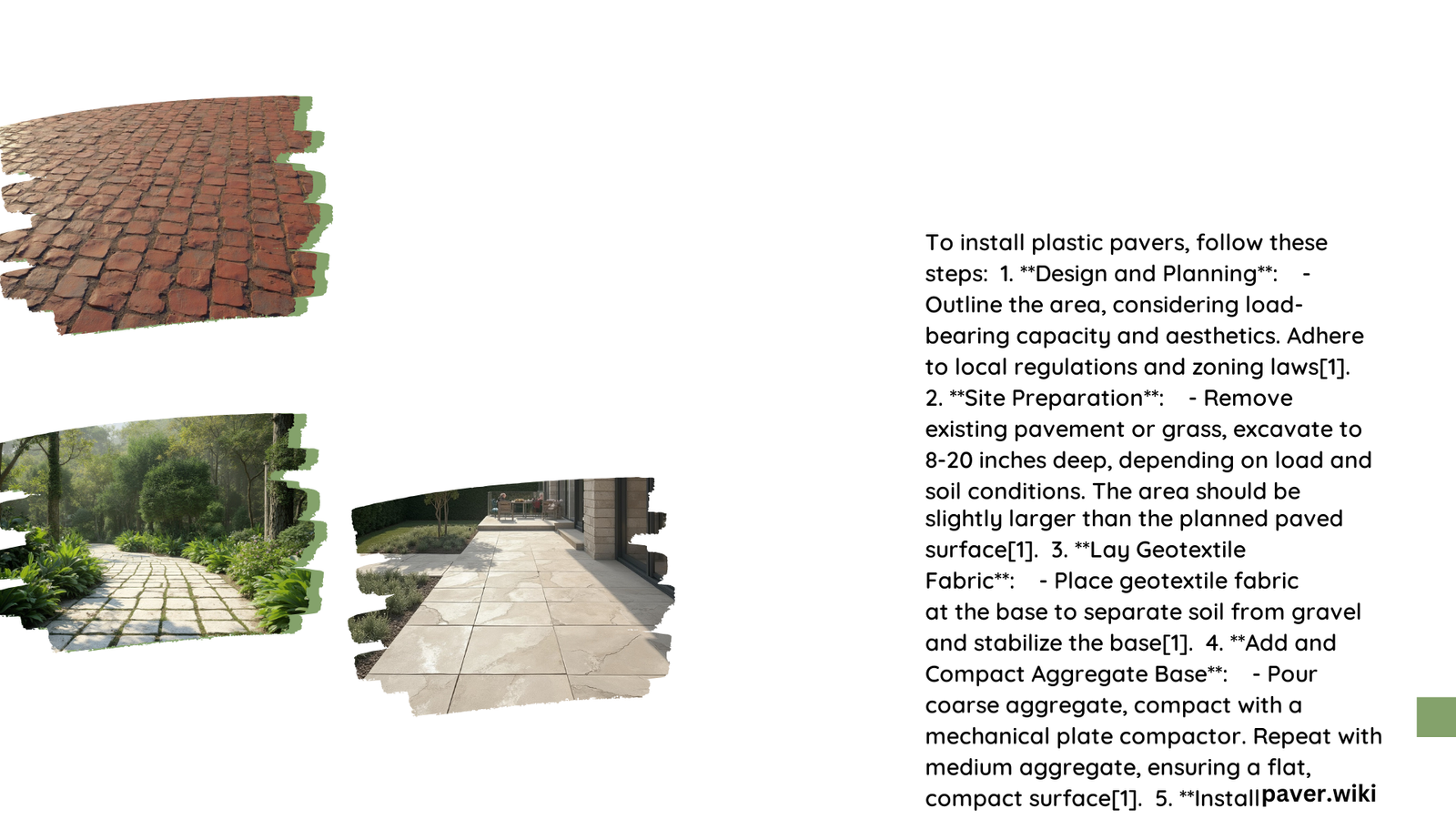Plastic pavers offer a durable, eco-friendly alternative to traditional paving materials. They are lightweight, easy to install, and provide excellent drainage. This guide covers the essential steps for installing plastic pavers, including base preparation, layout techniques, and maintenance tips. Whether you’re creating a new patio, walkway, or driveway, plastic pavers can be an excellent choice for your outdoor space.
What Are the Benefits of Plastic Pavers?
Plastic pavers offer several advantages over traditional paving materials:
- Lightweight and easy to handle
- Durable and resistant to cracking
- Excellent drainage properties
- Low maintenance requirements
- Environmentally friendly (often made from recycled materials)
- Versatile design options
How to Prepare the Site for Plastic Paver Installation?

Proper site preparation is crucial for a successful plastic paver installation. Follow these steps:
- Mark the area: Use stakes and string to outline the paving area.
- Excavate: Remove soil to a depth of 4-6 inches, depending on your base material choice.
- Level the ground: Use a rake and level to ensure a flat surface.
- Compact the soil: Use a plate compactor or hand tamper to create a firm base.
What Materials Are Needed for the Base?
The base materials for plastic pavers can vary depending on the installation method:
Traditional Method:
- 4-6 inches of 3/4-inch minus gravel
- 1 inch of bedding sand
Plastic Paver Base Panel Method:
- 1-2 inches of compacted sand or fine gravel
- Plastic paver base panels
How to Install Plastic Paver Base Panels?
If using plastic paver base panels, follow these steps:
- Lay a 1-2 inch layer of compacted sand or fine gravel.
- Place the panels over the sand bed, staggering them to avoid continuous seams.
- Ensure the panels are level and securely fastened together.
- Attach paver edging to the panels using stainless steel screws.
What Is the Process for Laying Plastic Pavers?
Once the base is prepared, follow these steps to lay the plastic pavers:
- Start at a corner and work outward.
- Use a chalk line to maintain alignment.
- Cut pavers as needed to fit the space.
- Ensure each paver is level with its neighbors.
- Fill gaps between pavers with polymeric sand if desired.
What Tools Are Essential for Installing Plastic Pavers?
Here’s a list of tools you’ll need for a successful installation:
| Tool | Purpose |
|---|---|
| Tape Measure | Measuring the area and materials |
| Level and String Line | Ensuring a level base and proper slope |
| Plate Compactor or Hand Tamper | Compacting base materials |
| Rubber Mallet | Setting pavers into place |
| Mason’s Saw or Splitter | Cutting pavers to fit |
| Garden Rake | Leveling ground and spreading materials |
| Shovels | Excavation and moving materials |
| Stakes and String | Marking the paving area |
| Concrete Trowel | Spreading and leveling sand |
| Hammer and Tin Snips | Installing edge restraint |
How to Ensure Proper Drainage with Plastic Pavers?
Proper drainage is essential to prevent water accumulation and potential damage. Follow these guidelines:
- Slope the paved area away from buildings (1 inch drop per 8 feet).
- Use a permeable base material to allow water to seep through.
- Consider installing a drainage system for large areas or heavy rainfall regions.
- Ensure gaps between pavers remain clear to allow water passage.
What Are the Best Practices for Maintaining Plastic Pavers?
To keep your plastic pavers looking great and functioning well:
- Sweep regularly to remove debris.
- Clean with mild detergent and water as needed.
- Avoid using harsh chemicals that could damage the pavers.
- Refill joints with sand if it becomes displaced.
- Inspect annually for any shifting or damage.
How to Address Common Issues with Plastic Pavers?
Despite their durability, plastic pavers may encounter some issues. Here’s how to address them:
Shifting Pavers
- Check the base for settling or erosion.
- Realign pavers and add sand to stabilize.
Weed Growth
- Use a weed preventer in the base material.
- Remove weeds promptly and refill joints with polymeric sand.
Staining
- Clean spills immediately to prevent staining.
- Use a plastic-safe cleaner for stubborn stains.
What Are the Environmental Considerations for Plastic Pavers?
Plastic pavers can be an eco-friendly choice:
- Often made from recycled materials
- Permeable designs reduce runoff and support groundwater recharge
- Durable nature means less frequent replacement
- Can be recycled at the end of their lifecycle
By choosing plastic pavers and installing them correctly, you can create a durable, attractive, and environmentally friendly outdoor space that will last for years to come.
References:
1. Family Handyman – How to Install a Paver Patio Base
2. Oregon State University Extension – 10-Step Guide to Installing Pavers
3. The Home Depot – How to Install Patio Pavers
